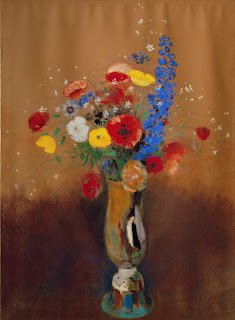Wednesday, June 3rd, 2009
Oz and Duchamp
 One of my favorite early twentieth century paintings is Marcel Duchamp’s Nude Descending a Staircase, No. 2 (1912, shown right). I used to joke that this painting must look even more interesting through 3-D glasses. In all honesty, though, I think that this painting is a fascinating depiction of animation, movement, and form.
One of my favorite early twentieth century paintings is Marcel Duchamp’s Nude Descending a Staircase, No. 2 (1912, shown right). I used to joke that this painting must look even more interesting through 3-D glasses. In all honesty, though, I think that this painting is a fascinating depiction of animation, movement, and form.
When looking at Nude Descending a Staircase, it’s easy to tell that Duchamp was particularly interested in the way form moves over time (he was inspired by Eadweard Muybridge’s photographic sequences), as well as the Cubist aesthetic. This painting also has been linked to Futurism, although Duchamp argued at the time that he had not seen any Futurist paintings first-hand.1
Duchamp became well-known in the United States after this painting was exhibited in the Armory Show in early 1913. Nude Descending a Staircase got a scandalous reception, and one critic described this work as “an explosion in a shingle factory.”2 Nonetheless, Duchamp’s status as a celebrity was solidified.
 Subsequently, Nude Descending a Staircase was copied and parodied throughout the United States, including the memorable cartoon Rude Descending a Staircase (Rush Hour at the Subway). Duchamp’s painting even inspired the children’s author L. Frank Baum. His character Woozy in The Patchwork Girl of Oz (1913) was inspired by Cubism and Nude Descending a Staircase. Woozy is a character made out of rectangles and squares (he is hugging a tree in the illustration on the left). Although Baum described Woozy as blue, the illustrator of the book (John R. Neill) colored Woozy brown like Duchamp’s nude.3 I was excited to learn this connection between Woozy and Duchamp. I grew up reading all of the Oz books, and it’s fun to find that fine art influenced Woozy’s character. I never would have made that connection when I was a kid!
Subsequently, Nude Descending a Staircase was copied and parodied throughout the United States, including the memorable cartoon Rude Descending a Staircase (Rush Hour at the Subway). Duchamp’s painting even inspired the children’s author L. Frank Baum. His character Woozy in The Patchwork Girl of Oz (1913) was inspired by Cubism and Nude Descending a Staircase. Woozy is a character made out of rectangles and squares (he is hugging a tree in the illustration on the left). Although Baum described Woozy as blue, the illustrator of the book (John R. Neill) colored Woozy brown like Duchamp’s nude.3 I was excited to learn this connection between Woozy and Duchamp. I grew up reading all of the Oz books, and it’s fun to find that fine art influenced Woozy’s character. I never would have made that connection when I was a kid!
1. “Duchamp, Marcel.” In Grove Art Online. Oxford Art Online, http://www.oxfordartonline.com.erl.lib.byu.edu/subscriber/article/grove/art/T023894 (accessed June 3, 2009).
2 Charles C. Eldredge, “The Arrival of European Modernism,” Art in America 61 (July-August 1973): 35.
3 Katharine M. Rogers, “L. Frank Baum: Creator of Oz,” (New York: St. Martin’s Press, 2002), 194.







